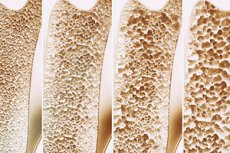New publications
New evidence-based guidelines for the management of osteoporosis in men
Last reviewed: 02.07.2025

All iLive content is medically reviewed or fact checked to ensure as much factual accuracy as possible.
We have strict sourcing guidelines and only link to reputable media sites, academic research institutions and, whenever possible, medically peer reviewed studies. Note that the numbers in parentheses ([1], [2], etc.) are clickable links to these studies.
If you feel that any of our content is inaccurate, out-of-date, or otherwise questionable, please select it and press Ctrl + Enter.

It is estimated that one in five men over age 50 will experience an osteoporotic fracture in their remaining lifetime, and the incidence of hip fractures in men is expected to increase by approximately 310% from 1990 to 2050. Despite the significant burden of osteoporosis among older men, the disease is still often viewed as a "women's" problem, and underdiagnosis and treatment of osteoporosis in men is even more common than in women.
In response, the European Society for Clinical and Economic Aspects of Osteoporosis, Osteoarthritis and Musculoskeletal Diseases (ESCEO) international multidisciplinary working group issued recommendations based on the GRADE methodology for the diagnosis, monitoring and treatment of osteoporosis in men.
Professor Jean-Yves Regenster, senior author and president of ESCEO, said: "It is important to recognise that osteoporosis in men is associated with significant morbidity and mortality, comparable or even greater than that seen in women with the disease."
"The ESCEO International Working Group was established to provide new recommendations for the management of osteoporosis based on the latest research advances and current expert opinions related to diagnostic and screening approaches for osteoporosis and its high fracture risk in men."
The working group's recommendations cover disease burden, approaches to fracture risk assessment in men, including correct interpretation of bone density and absolute fracture risk, treatment thresholds and therapeutic interventions together with their health economic evaluation.
The guidelines also noted the need for additional research to examine the effectiveness of osteoporosis drugs, including denosumab and bone-forming therapies.
Key recommendations and guidelines that may be particularly useful for clinicians include:
- For densitometric diagnosis of osteoporosis in men, a female reference database should be used.
- FRAX is a suitable tool for assessing fracture risk and setting intervention thresholds in men with osteoporosis.
- Thresholds for FRAX-based intervention should be age-dependent in men with osteoporosis.
- Trabecular bone index, used in conjunction with BMD and FRAX probability, provides useful information for assessing fracture risk in men.
- All men with a previous fragility fracture should be considered for treatment with antiosteoporosis drugs.
- The treatment regimen for osteoporosis in men should be tailored to the baseline fracture risk.
- Vitamin D and calcium should be provided to all men over 65 years of age.
- Oral bisphosphonates (alendronate or risedronate) are first-line drugs for men at high risk of fractures.
- Denosumab or zoledronate are second-line drugs for men at high risk of fractures.
- Sequential therapy, starting with a bone-forming agent followed by an anti-resorption agent, should be considered for men at very high risk of fracture.
- Biochemical markers of bone turnover are a suitable tool for assessing adherence to anti-resorptive therapy in men.
- Bone-forming agents prescribed as first-line treatment in men at very high risk of fracture should be used according to regulatory guidelines.
- Exercise and a balanced diet should be recommended for all men with osteoporosis.
- Serum total testosterone levels should be assessed as part of the pre-treatment evaluation in men with osteoporosis.
- Hormone replacement therapy should be considered in men with low total or free testosterone levels.
- Based on available BMD data, abaloparatide is considered an appropriate first-line drug for men with osteoporosis at very high risk of osteoporotic fracture.
Professor Nicholas Harvey, senior author and Chair of the International Osteoporosis Foundation (IOF) Scientific Advisory Committee, said: "We hope these guidelines will assist clinicians in their practice and encourage them to actively manage osteoporosis in their male patients."
"Following an approach similar to that recommended for women with osteoporosis, we recommend using oral anti-resorptive agents as first-line treatment in men at high fracture risk and bone-forming agents followed by anti-resorptive agents in men at very high fracture risk."
IOF Director General Dr Philippe Halbaut concluded: “Osteoporosis in men represents a huge global burden and must be urgently addressed by healthcare professionals and public health authorities. As the largest global organisation in the field of osteoporosis, IOF welcomes the publication of this important new guideline, which we hope will contribute to better patient care and reduce the devastating impact of osteoporosis in older men worldwide.”
The work was published in the journal Nature Reviews Rheumatology.
